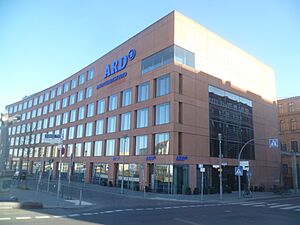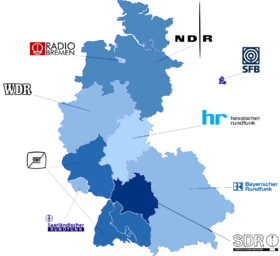ARD (broadcaster) facts for kids
 |
|
| Type | Broadcast radio, television and online |
|---|---|
| Country | Germany |
| Availability | Worldwide |
| Owner | Member broadcasters |
| Key people | Florian Hager (HR), Chairman |
| Launch date | 5 June 1950 |
ARD is a big group of public TV and radio stations in Germany. Its full name means "Working group of public broadcasters of the Federal Republic of Germany." It was started in 1950 in West Germany. The main goal was to help the new, local broadcasting services work together. They especially wanted to create a shared TV network.
ARD is one of the largest public broadcasters in the world. It has a budget of about €6.9 billion and over 22,000 employees. Most of its money comes from a special fee. Every household, company, and public place in Germany pays this fee. It costs €18.36 per month for a regular home as of 2023. Homes receiving welfare do not have to pay. A special office called the Beitragsservice collects these fees. This office works for ARD, another public TV channel called ZDF, and Deutschlandradio.
ARD runs a national TV channel called Das Erste. This name means "The First Channel." It helps tell it apart from ZDF, which is "The Second Channel." Das Erste started broadcasting on October 31, 1954. It was first called Deutsches Fernsehen ("German Television"). Later, it became Erstes Deutsches Fernsehen and then Das Erste in 1994. You can watch ARD's shows through regular TV signals, cable, satellite, and online.
ARD also makes other free TV channels like One and Tagesschau24. It also helps create channels such as Phoenix (for news and documentaries), KiKa (for kids), 3sat (for culture), arte (a German-French cultural channel), and Funk (an online service for teenagers).
ARD's shows are made by its regional members. These include stations like Bayerischer Rundfunk (BR) and Norddeutscher Rundfunk (NDR). These regional stations run 54 local radio stations and seven regional TV networks. Deutsche Welle, Germany's international broadcaster, is also part of ARD.
Contents
How ARD Started
What "Public-Service" Means
ARD is a "public-service" broadcaster. This means it is not owned by private companies. It is also not controlled by the government. Instead, it is set up as an "Institution under Public Law." This type of organization is non-government and non-profit. It has its own management. Two groups, the Broadcasting Council and the Administration Council, oversee it. These groups include people from different parts of German public life. This setup helps keep ARD independent.
Early Years: 1940s and 1950s
After World War II, the winning countries wanted German radio to be different. They did not want it to spread propaganda like before the war. So, they decided that radio and TV stations should be independent. They should not be controlled by the government or by businesses. This idea of independent public broadcasting was very important.
ARD's first members included stations like Nordwestdeutscher Rundfunk (NWDR) and Bayerischer Rundfunk (BR). These stations were in different parts of West Germany. The new organization was paid for by a required fee. Every German home with a radio had to pay it. Each station received the money collected in its own state. Larger ARD members also helped support smaller ones.
In the 1950s, ARD's radio stations became very popular. By 1952, they had ten million listeners. But ARD really grew when it started a TV network for the whole country. In 1952, ARD also joined the European Broadcasting Union. The "German sound archive" was also created as a shared resource.
In 1955, the founding member NWDR split into two new stations: NDR and WDR. The first daily news show, Tagesschau, started in Hamburg in 1952. The famous 8:00 PM sound and announcement, "This is the first German television channel with the Tagesschau," is still a symbol of ARD today. This news show gets about 8 million viewers on average.
Growing Up: 1960s–1980s
In the 1960s, more and more people in Germany got televisions. Color TV shows started in 1967. For a long time, ARD stations did not have competition from private TV channels in Germany. This helped them become modern and respected broadcasters. ZDF, another public TV channel, started in 1963. But ARD did not face private competition in Germany until 1984.
ARD stations also played a big role in German politics. News shows like Monitor and Panorama still reach millions of viewers. These shows often did investigative reporting. For example, the environmental movement grew in the 1980s partly because of things ARD revealed.
When private TV channels were allowed in Germany in the mid-1980s, ARD changed a bit. It started making more popular shows for its national channels. Many cultural and news programs moved to the regional channels or new special channels.
ARD TV was also very important for people in East Germany. An ARD office opened in East Berlin in 1974. This made ARD TV the main source of information for East German citizens. About 80% of them could watch "Westfernsehen" (West TV). Even though East German authorities tried to stop them, ARD's Tagesschau reported on the Leipzig Monday Demonstrations in September 1989. This helped people in East Germany learn what was happening.
Changes in the 1990s
After Germany became one country again, two new regional broadcasters started in the East. They joined ARD in 1992. These were Mitteldeutscher Rundfunk (MDR) and Ostdeutscher Rundfunk Brandenburg (ORB). The existing NDR service also grew into the north-east. Later, ORB joined with Sender Freies Berlin (SFB) to become Rundfunk Berlin-Brandenburg (RBB) in 2003.
Another merger happened in 1998. Süddeutscher Rundfunk (SDR) and Südwestfunk (SWF) joined to become Südwestrundfunk (SWR).
What ARD Broadcasts
Radio Programs
ARD member stations usually create their own radio shows. Some stations work together on common radio services. For example, Nordwestradio is a cultural station made by Radio Bremen and NDR. Most ARD stations have a news radio station, a classical music station, a youth station, and a cultural station. At night, some stations share common programs. These include Hitnacht (light music), Nachtkonzert (classical music), Infonacht (all news), and Popnacht (pop music). Most services are on FM radio, and some are also available digitally.
There is also Deutschlandradio, which is not an ARD member. It is controlled by both ARD and ZDF. Deutschlandradio offers two main radio services: Deutschlandfunk (DLF) for news and Deutschlandfunk Kultur for culture. It also has an online science channel called Deutschlandfunk Nova.
ARD's most famous radio station outside Germany is Deutsche Welle. It broadcasts radio shows around the world in many languages. You can listen to it online and on partner FM stations. Deutsche Welle does not broadcast on FM in Germany.
"Archivradio" is an ARD online radio station. It plays old audio from German sound archives. This includes ARD's own radio archives. A website with more information goes along with the program.
Television Channels
ARD's main TV channels are the national channel Das Erste and seven regional channels. These regional channels are run by the different regional broadcasting groups. Das Erste and the regional channels are mainly paid for by the licence fees. They also have a small amount of advertising.
Das Erste broadcasts across Germany 24 hours a day. It also shares some programming with ZDF. For example, they take turns producing the news shows Morgenmagazin and Mittagsmagazin on weekdays. In March 2008, Das Erste had a 12.5% audience share.
The regional ARD members run their own regional channels. These are often called die Dritten ("the Third Programmes"). They used to have names like West 3 and Hessen 3. These regional channels also have special local news segments at certain times.
- BR Fernsehen from Bayerischer Rundfunk (for Bavaria)
- hr-fernsehen from Hessischer Rundfunk (for Hesse)
- MDR Fernsehen from Mitteldeutscher Rundfunk (for Saxony, Saxony-Anhalt, Thuringia)
- NDR Fernsehen from Norddeutscher Rundfunk (for Hamburg, Lower Saxony, Schleswig-Holstein, Mecklenburg-Vorpommern, and rb.tv from Radio Bremen)
- RBB Fernsehen from Rundfunk Berlin-Brandenburg (for Berlin and Brandenburg)
- SWR Fernsehen from Südwestrundfunk (for Baden-Württemberg and Rhineland-Palatinate, with SR Fernsehen from Saarländischer Rundfunk for Saarland)
- WDR Fernsehen from Westdeutscher Rundfunk (for North Rhine-Westphalia, with 11 local opt-outs)
ARD also has three more channels as part of its digital package:
- Tagesschau24 – a TV news channel
- One – an entertainment TV channel
- ARD-alpha – an educational programming channel
ARD is also part of several joint channels with other broadcasters:
- 3sat with ZDF, ORF, and SRG: a channel for culture
- KI.KA with ZDF: a channel for children
- Arte with ZDF and France Télévisions: a German-French cultural channel
- Phoenix with ZDF: a news and documentary channel, showing live press conferences and political debates.
The international broadcaster Deutsche Welle also makes TV shows. These are mostly available through satellite.
Podcasts
The Tagesschau news show, made by ARD every night, is available as a podcast on the ARD website. You can get it as audio only or with video. Other audio programs from ARD's members (like BR and MDR) and Deutsche Welle are also available as podcasts on their websites.
ARD's Member Organizations
ARD is made up of several regional broadcasters. Each one covers a specific part of Germany.
| Regional broadcaster | Abbreviation | Main office location(s) | Year of establishment | Region of coverage |
|---|---|---|---|---|
| Bayerischer Rundfunk (Bavarian Broadcasting) | BR | Munich | 1949 | Bavaria |
| Deutsche Welle ("German Wave") | DW | Bonn | 1953 | International |
| Hessischer Rundfunk (Hessian Broadcasting) | HR | Frankfurt | 1948 | Hesse |
| Mitteldeutscher Rundfunk (Central German Broadcasting) | MDR | Leipzig | 1991 | Saxony, Saxony-Anhalt, Thuringia |
| Norddeutscher Rundfunk (North German Broadcasting) | NDR | Hamburg | 1956 | Hamburg, Lower Saxony, Schleswig-Holstein, Mecklenburg-Vorpommern |
| Radio Bremen | RB | Bremen | 1945 | Bremen |
| Rundfunk Berlin-Brandenburg (Berlin-Brandenburg Broadcasting) | RBB | Berlin, Potsdam | 2003 | Berlin, Brandenburg |
| Saarländischer Rundfunk (Saarland Broadcasting) | SR | Saarbrücken | 1957 | Saarland |
| Südwestrundfunk (Southwest Broadcasting) | SWR | Stuttgart, Mainz, Baden-Baden | 1998 | Baden-Württemberg, Rhineland-Palatinate |
| Westdeutscher Rundfunk (West German Broadcasting) | WDR | Cologne | 1956 | North Rhine-Westphalia |
ARD also has 30 offices with correspondents in 26 countries around the world. These reporters send back news and stories from different parts of the globe.
ARD also runs other companies and groups, sometimes with ZDF. These include Degeto Film, which buys and makes TV rights and shows. There is also the German Broadcasting Archive (DRA) and the Institute for Broadcasting Technology (IRT), which does research. The Fee Collection Service (Beitragsservice) is another important part of ARD.
ARD Logos Over Time
See also
 In Spanish: ARD para niños
In Spanish: ARD para niños
- Television in Germany
- Zweites Deutsches Fernsehen (Second German TV channel)
- List of German-language television channels








